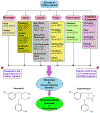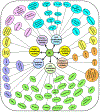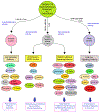Anticancer and antimetastatic potential of enterolactone: Clinical, preclinical and mechanistic perspectives
- PMID: 30771348
- PMCID: PMC6938675
- DOI: 10.1016/j.ejphar.2019.02.022
Anticancer and antimetastatic potential of enterolactone: Clinical, preclinical and mechanistic perspectives
Abstract
Currently cancer is the second leading cause of death globally and worldwide incidence and mortality rates of all cancers of males and females are rising tremendously. In spite of advances in chemotherapy and radiation, metastasis and recurrence are considered as the major causes of cancer related deaths. Hence there is a mounting need to develop new therapeutic modalities to treat metastasis and recurrence in cancers. A significant amount of substantiation from epidemiological, clinical and laboratory research highlights the importance of diet and nutrition in cancer chemoprevention. Enterolactone (EL) is a bioactive phenolic metabolite known as a mammalian lignan derived from dietary lignans. Here in we review the reported anti-cancer properties of EL at preclinical as well as clinical level. Several in-vivo and in-vitro studies have provided strong evidence that EL exhibits potent anti-cancer and/or protective properties against different cancers including breast, prostate, colo-rectal, lung, ovarian, endometrial, cervical cancers and hepatocellular carcinoma. Reported laboratory studies indicate a clear role for EL in preventing cancer progression at various stages including cancer cell proliferation, survival, angiogenesis, inflammation and metastasis. In clinical settings, EL has been reported to reduce risk, decrease mortality rate and improve overall survival particularly in breast, prostate, colon, gastric and lung cancer. Further, the in-vitro human cell culture studies provide strong evidence of the anticancer and antimetastatic mechanisms of EL in several cancers. This comprehensive review supports an idea of projecting EL as a promising candidate for developing anticancer drug or adjunct dietary supplements and nutraceuticals.
Keywords: Anti-metastatic activity; Anticancer; Dietary Lignans; Enterolactone; Flax seeds; Mammalian Lignans.
Copyright © 2019. Published by Elsevier B.V.
Conflict of interest statement
Conflict of interest
This work was supported by an institutional funding. Authors declared no potential conflicts of interest.
Figures



Similar articles
-
In vitro anti-metastatic activity of enterolactone, a mammalian lignan derived from flax lignan, and down-regulation of matrix metalloproteinases in MCF-7 and MDA MB 231 cell lines.Indian J Cancer. 2012 Jan-Mar;49(1):181-7. doi: 10.4103/0019-509X.98948. Indian J Cancer. 2012. PMID: 22842186
-
Enterolactone alters FAK-Src signaling and suppresses migration and invasion of lung cancer cell lines.BMC Complement Altern Med. 2017 Jan 9;17(1):30. doi: 10.1186/s12906-016-1512-3. BMC Complement Altern Med. 2017. PMID: 28068967 Free PMC article.
-
Enterolactone has stronger effects than enterodiol on ovarian cancer.J Ovarian Res. 2017 Jul 24;10(1):49. doi: 10.1186/s13048-017-0346-z. J Ovarian Res. 2017. PMID: 28738876 Free PMC article.
-
Lignans and human health.Crit Rev Clin Lab Sci. 2007;44(5-6):483-525. doi: 10.1080/10408360701612942. Crit Rev Clin Lab Sci. 2007. PMID: 17943494 Review.
-
Mammalian phytoestrogens: enterodiol and enterolactone.J Chromatogr B Analyt Technol Biomed Life Sci. 2002 Sep 25;777(1-2):289-309. doi: 10.1016/s1570-0232(02)00281-7. J Chromatogr B Analyt Technol Biomed Life Sci. 2002. PMID: 12270221 Review.
Cited by
-
Identification of lapatinib sensitivity-related genes by integrative functional module analysis.Transl Cancer Res. 2020 Mar;9(3):1351-1360. doi: 10.21037/tcr.2020.01.30. Transl Cancer Res. 2020. PMID: 35117483 Free PMC article.
-
Genes Associated with the Flax Plant Type (Oil or Fiber) Identified Based on Genome and Transcriptome Sequencing Data.Plants (Basel). 2021 Nov 28;10(12):2616. doi: 10.3390/plants10122616. Plants (Basel). 2021. PMID: 34961087 Free PMC article.
-
Dietary Phytoestrogens and Their Metabolites as Epigenetic Modulators with Impact on Human Health.Antioxidants (Basel). 2021 Nov 26;10(12):1893. doi: 10.3390/antiox10121893. Antioxidants (Basel). 2021. PMID: 34942997 Free PMC article. Review.
-
Dietary Flaxseed as a Strategy for Improving Human Health.Nutrients. 2019 May 25;11(5):1171. doi: 10.3390/nu11051171. Nutrients. 2019. PMID: 31130604 Free PMC article. Review.
-
Autophagy characteristics of phytoestrogens in management and prevention of diseases: A narrative review of in-vivo and in-vitro studies.J Adv Vet Anim Res. 2023 Jun 30;10(2):308-320. doi: 10.5455/javar.2023.j683. eCollection 2023 Jun. J Adv Vet Anim Res. 2023. PMID: 37534069 Free PMC article. Review.
References
-
- Aarestrup J, Kyro C, Knudsen KEB, Weiderpass E, Christensen J, Kristensen M, Würtz AML, Johnsen NF, Overvad K, Tjonneland A, Olsen A, 2013. Plasma enterolactone and incidence of endometrial cancer in a case-cohort study of Danish women. Br. J. Nutr 109, 2269–2275. 10.1017/S0007114512004424. - DOI - PubMed
-
- Adlercreutz H, Heikkinen R, Woods M, Fotsis T, Dwyer JT, Goldin BR, Gorbach SL, 1982. Excretion of the lignans enterolactone and enterodiol and of equol in omnivorous and vegetarian postmenopausal women and in women with breast cancer. Lancet 320, 1295–1299. 10.1016/S0140-6736(82)91507-0. - DOI - PubMed
Publication types
MeSH terms
Substances
Grants and funding
LinkOut - more resources
Full Text Sources

